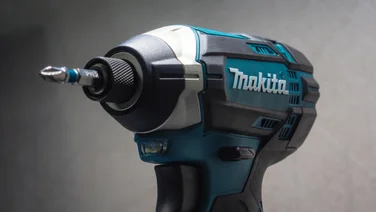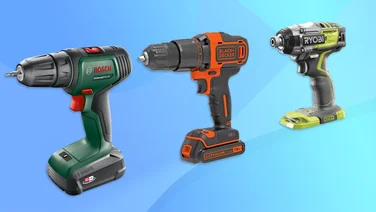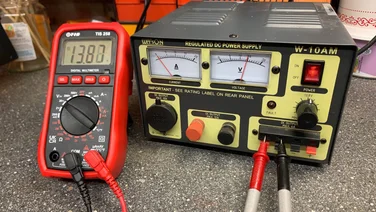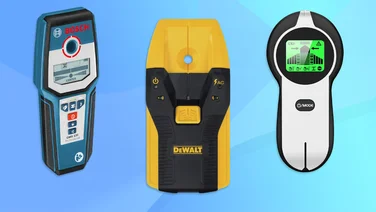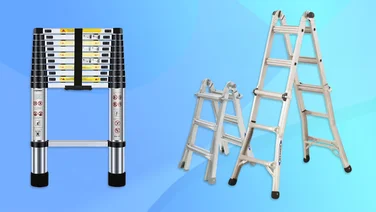To help us provide you with free impartial advice, we may earn a commission if you buy through links on our site. Learn more
- Best sander: At a glance
- How we test sanders
- The best sanders you can buy in 2024
- 1. Bosch PEX 220 A: Best orbital sander
- 2. Worx Sandeck WX820: Best multi-function sander
- 3. Bosch PSM 100 A: Best detail sander
- 4. Makita BO4556: Best value finishing sander
- 5. Makita DBO180Z: Best cordless orbital sander
- How to choose the best sander for you

Whether you’re sanding new wooden kitchen worktops or making your own shelves, the best electric sanders are must-have tools for woodworkers. However, with hundreds of options available, it can be tough to narrow down the right sander for the job.
That’s why our team of experts have personally tested all five sanders featured in our roundup below. Our testing methodology involved using the sanders on various types of wood along with different sandpaper grades, taking note of key features such as ergonomics, weight, power, speed and effectiveness. All sanders were used in the same environment for the same length of time in order to ensure a fair assessment.
You can find our detailed buying guide, which breaks down the various types of sanders and their strengths and weaknesses, at the bottom of this page. To skip straight ahead to our curated list of favourites, however, click here.
Best sander: At a glance
| Best orbital sander | Bosch PEX 220 A (~£44) | |
| Best multi-function sander | Worx Sandeck WX820 (~£126) | |
| Best detail sander | Bosch PSM 100 A (~£40) | |
| Best cordless orbital sander | Makita DBO180Z (~£89) |
How we test sanders
At Expert Reviews, we know that employing a product for its intended use out in the real world is the only way to truly be able to give valuable, and reliable, buying advice. So we personally used all of the sanders reviewed in this article, ensuring that we tested out each one fully. Which means using them at all of the available speeds and in all of the available modes or, where applicable, with all of the different attachments. For it to be a fair test, all of the sanders were used in the same environment – outdoors, in dry weather – and all of the cordless models were tested with fully charged batteries.
We used the sanders on a range of different types of wood, including some with large surface areas, and others with hard-to-reach sections. We also used them with different sandpaper grades to evaluate how each one performs. All of the sanders were used for long enough to be able to assess their ergonomics, including weight and dimensions.
You can see all key specifications listed below each model.
The best sanders you can buy in 2024
1. Bosch PEX 220 A: Best orbital sander
Price when reviewed: £52 | Check price at Amazon

- Great for… User-friendly, lightweight
- Not so great for… Doesn’t offer variable speed
If you’re looking for a versatile corded sander then the PEX 220 A from Bosch is a great purchase. We found it incredibly easy to use: its velcro-type fastening allows you to replace sanding sheets in a matter of seconds, and the toggle on/off switch leaves your fingers free to hold the device via the soft and contoured grip.
The PEX 220 A is suitable for a wide range of tasks with a powerful 220W motor combined with a lightweight, compact design. The 125mm disc size means it’s both small enough to tackle tricky areas but big enough to use for sanding something larger like a door or worktop – flat or curved.
The small but effective Microfilter dust box helps to keep dust to a minimum, too, although it can be a little hard to clip back in after emptying.
Key specs – Weight: 1.2kg; Maximum speed: 24,000opm; Pad diameter: 125mm; Orbit diameter: 2.5mm; Lock-on switch: Yes; Variable speed: No; Dust box: Yes; Power rating: 220W
2. Worx Sandeck WX820: Best multi-function sander
Price when reviewed: £120 (without battery) £140 (with battery) | Check price at Amazon

- Great for… Incredibly versatile, six speeds
- Not so great for… Not as powerful as a corded sander
One sander to rule them all? The Sandeck WX820 from Worx is an excellent option for those that want to have various different sanders without having to buy multiple machines. The WX820 is effectively five sanders in one thanks to its range of interchangeable heads.
You get a finishing sander, orbital sander, detail sander, finger sander and curved area sander. There’s no need to faff around with Allen keys or other tools to swap them around thanks to the ‘hyperlock’ clamping system which Worx says provides 1 ton of clamping force. Unlike a lot of sanders, it also comes with a hard carry case making it easy to store and transport.
The WX820 comes with a microfilter dust box and gives you plenty of control thanks to six different speed options. It’s not as powerful as a corded sander, but the battery means you can use it anywhere and is interchangeable with other Worx Powershare tools.
Key specs – Weight: 2kg; Maximum speed: 10,000opm; Pad diameter: Various; Orbit diameter: Up to 2.5mm; Lock-on switch: Yes; Variable speed: Yes, 6 speeds; Dust box: Yes; Power rating: 40W
3. Bosch PSM 100 A: Best detail sander
Price when reviewed: £39 | Check price at Wickes

- Great for… Compact, precise
- Not so great for… Bigger jobs, single speed
The PSM 100 A from Bosch is a great option for those that want a compact sander for fiddly, hard to reach areas or precision tasks. Like its bigger brother, the PEX 220 A, we found this sander incredibly easy to get to grips with, making it great for beginners – simply attach a sanding sheet, insert the dust box, plug in the power cord and away you go.
Bosch offers a comfortable contoured shape with a soft grip and an easy-to-use toggle switch. The dust box is small but you can optionally attach the PSM 100 A to a vacuum cleaner for even less dirt. The triangular pointed shape of the sanding plate means you can get into corners and the plate can be rotated to extend its lifespan. Unlike many detail sanders, there’s a second section to the sanding plate for when more surface area is needed.
Key specs – Weight: 0.9kg; Maximum speed: 26,000opm; Pad size: 104 cm2; Orbit diameter: 1.4mm; Lock-on switch: Yes; Variable speed: No; Dust box: Yes; Power rating: 100W
4. Makita BO4556: Best value finishing sander
Price when reviewed: £56 | Check price at Powertool World

- Great for… Easy to use, affordable
- Not so great for… Short cable, punch plate provided is a bit weak
A finishing sander (aka palm sander) is a popular choice for various DIY projects and the BO4556 (almost identical to the BO4555) is an excellent value option, providing a simple and effective tool without breaking the bank.
As is typical for this type of sander, the BO4556 is compact and lightweight with single-speed operation. It’s easy to use thanks to its toggle switch and soft non-slip elastomer grip, and even has an effective dust bag which isn’t a given for affordable finishing sanders. What’s more, you can make use of regular sheets of sanding paper via the simple clamp system.
On the downside, the cable isn’t very long and if you want to save yourself some bother make sure to buy pre-pierced sanding sheets as the provided punch plate isn’t great.
Key specs – Weight: 1.1kg; Maximum speed: 14,000opm; Pad size: 112x102mm; Orbit diameter: 1.5mm; Lock-on switch: Yes; Variable speed: No; Dust box: Yes; Power rating: 200W
5. Makita DBO180Z: Best cordless orbital sander
Price when reviewed: £89 (without battery) | Check price at Amazon

- Great for… Various speed settings, cordless
- Not so great for… Grip is tricky to access
Those looking specifically for a cordless orbital sander won’t be disappointed with the DBO180Z from Makita, which is available with or without the battery and charger. Its cordless design means you’re not tied to a power socket, and it took only 36 minutes to charge in our tests. You should get around 45 minutes of runtime at the highest speed and can quickly swap the battery if you have a spare.
The design is taller than corded sanders and you have to factor in the weight of the battery, which also gets in the way of the grip a fair bit, but it’s easy to use and offers three different speed settings giving you good control. A maximum speed of 11,000opm (orbits per minute) isn’t particularly high but the DBO180Z makes up for it somewhat with a large 2.8mm orbit diameter. During testing, we found that dust extraction is above average and the machine is quiet in operation.
Key specs – Weight: 1.7kg; Maximum speed: 11,000opm; Pad diameter: 125mm; Orbit diameter: 2.8mm; Lock-on switch: Yes; Variable speed: Yes, 3 speeds; Dust box: Yes; Power rating: 190W
How to choose the best sander for you
What type of sander should I buy?
There are typically six types of sander. Some are more versatile and can be used for multiple jobs, while others are more specialist. Below is a short summary of the main models and how they differ from each other.
Belt sander: As the name suggests, this type of sander has a belt that goes around in a constant loop, taking the sandpaper with it. These are seriously powerful and can easily deal with removing thick coatings of paint or shaping wood before more refined tools are introduced. Don’t underestimate their sanding power: belt sanders require skill to use if you don’t want to accidentally take chunks out of your material.
Random orbital sander: If you can only afford one sander, a random orbital is the most versatile. They are typically circular, but not exclusively, and although it might look like they simply rotate the sanding disc, they actually move it around in an unpredictable pattern to avoid scratch marks. Their size and ease-of-use make them suitable for a wide range of sanding tasks.
Disc sander: A disc sander is probably what most people think a random orbital sander is. The key difference is that they do spin in a fixed motion, much like the wheel on a car. They typically require two-handed operation and, like belt sanders, are better for tougher jobs where lots of material needs removing. The fixed motion means you need to be careful not to leave visible circle marks behind.
Finishing sander: A finishing sander, as you might expect, is the one you need to put the finishing touches on a job. They come in different shapes and sizes which means you will sometimes see them described as palm sanders, and are ideal for working on flat areas before adding products like oil, wax and paint.
Detail sanders: In many ways, a detail sander is a type of finishing sander. Typically, they have a triangular shape with curved sides, and this makes them less suitable for larger areas. They are, however, ideal for precise tasks like edges or harder to reach places.
Multi-function sander: A fifth option that might be ideal for many DIYers is a multi-function sander. A bit like a socket set, these sanders come with interchangeable heads so you’re not limited to one type of sanding. If you want the most versatile all-in-one solution, this is the way to go.
READ NEXT: The best tool boxes to buy
What else should I look out for?
Once you’ve decided which type of sander you need, there are a few things to look out for before making your final choice.
Make sure the sander has the right type of grip for you. Some are one-handed while others can facilitate two, either in the main grip or with an additional handle. A soft rubber grip will help you control your sander and avoid mistakes.Sanding creates a lot of dust so it’s a good idea to look for a sander with good dust collection as not all sanders come with this feature. Typically it will come in the form of a built-in dust compartment but some can even be attached to a vacuum cleaner tube for better extraction.
A lot of sanders come with a simple on/off switch but some offer variable speeds to provide more control. A slower speed will ensure material isn’t removed too quickly, while full speed is great for quick progress as well as polishing.
Whether the speed is variable or not, a lock-on switch can be very useful for lengthy jobs so you don’t have to hold the power button down the entire time you’re sanding.
You also need to check what size and type of sandpaper the sander takes. Some allow regular sheets to be cut to size and clamped into place while others must be the correct size and simply attach via a hook and loop fixing such as Velcro.
Should I buy corded or cordless?
This all comes down to how and where you want to use your sander. Firstly think about whether there is going to be a power socket available where you are sanding, or even if you can run an extension cable. If not, then a cordless battery-powered sander is the answer.
If there is power available then a corded sander makes life simpler in many ways as you don’t need to worry about charging batteries or replacing them when they are old. You just need to deal with a cable potentially getting in the way.
How much do I need to spend?
Sanders can easily cost less than £30 but this will likely limit you to a small detail sander or a palm finishing sander. You will need to spend more for more powerful, feature-packed versions or other types of sander: sanders can range from £50 for a cheap random orbital to over £250 for a professional-grade belt sander.
READ NEXT: Our pick of the best cordless screwdrivers







